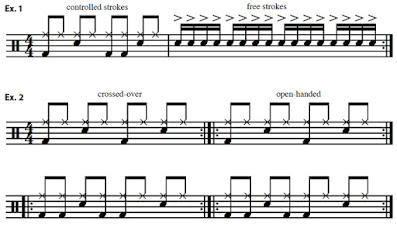MUSIC TYPES
When it comes to different styles of drumming, this could be referring to many aspects. For a start, just like you can have a style of music, you can have a style of drumming to go with it. Jazz, Blues and Rock all have certain nuances, phrases, techniques, and sounds which are associated with the style of drumming that accompanies them. Alternatively you can also compare acoustic drumming and electronic drum sets.
ROCK
Rock music is a huge genre. It encompasses everything from the 1950’s to modern day and beyond.
What really distinguishes rock music from any other music is the use of a backbeat. The backbeat became popular in the 1950’s and 1960’s and took off in its own way to spawn lots of different types of music.
A backbeat is typically a snare stroke which is placed on beats 2 and 4 of the bar, in a standard bar of 4/4. The effect a backbeat has on a song is undeniable and infectious.
Before backbeats were widely used jazz drummers would often accent beats 2 and 4 of the bar. This would be in a typical swing pattern. The way they would accent these beats was by pressing down on the hi-hat pedal and playing the ride cymbal a little louder. This extra volume on these two beats really enhanced the “swing” feel.
So this style made its way into early rock’n’roll music. The hi-hat and ride combination was replaced with a stronger snare stroke. Also swing eventually gave way to a more straight sounding eight note pattern. The result is a typical rock beat that you might hear today.
Blues is closely related to rock and quite close to jazz, too, in some ways. Blues drumming can usually be divided into one of three categories to begin with. You can have straight eight blues, shuffle blues, or 12/8 blues. There are more variations but we’ll deal with these three as they happen to make up the majority of cases.
Straight eight blues is close to the rock beat as demonstrated in the earlier ZZ Top demonstration. “Straight eight” really refers to how the time is played. The hi-hats in this example are played straight, so this means that the timing between consecutive eight notes is equal. You can mix up the placement of both snare and bass drum to create new patterns but the main timekeeper here is played straight.
Shuffle blues on the other hand means that the pattern is not straight. Instead, the eight notes are played with more of a bounce where the notes are not equally spaced. This feel is very familiar and can be heard in countless tunes from jazz, rock, pop, and more.
Jazz
One of the most famous examples of the swing ride pattern, which is essential to jazz drumming, is on the soundtrack to the legendary Pink Panther movie
Jazz is in no way restricted to swing. In fact, jazz may be the most all-encompassing music out there, as jazz musicians are constantly welcoming new styles and sounds into the idiom.
You’ll find plenty of straight eight jazz music, as well as shuffles and pretty much any other rhythm there is.
Reggae can also be swung or played straight. One of the most common characteristics of reggae is the avoidance of overplaying on beat 1. Emphasizing the first beat is more common in lots of rock and pop tunes and not so common in the likes of jazz and reggae.
Effectively, this means that you shouldn’t play too loud on this beat. More popular beats are the 2, 3, and 4 of the bar. Expert reggae drummers will craft fills and beats to highlight these beats.


Σχόλια
Δημοσίευση σχολίου